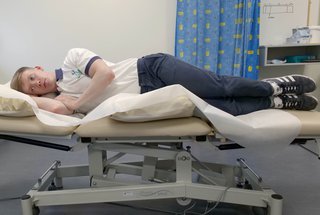You may find that you are still coughing up phlegm or mucus after an infection with COVID-19 (coronavirus). This is normal after respiratory infections. It is how the lungs and airways keep themselves clear.
Keep clearing the phlegm from your lungs to improve your lung condition and reduce the chance of getting chest infections.
There are breathing exercises and positioning exercises that can help clear phlegm better.
Keeping your chest clear
To help keep your chest clear:
- keep upright as much as possible unless a physiotherapist advises you to try other positions
- take any medicines you are prescribed
- drink plenty of fluids to stay well hydrated
- keep active and do gentle physical activity
Breathing exercises
Give yourself time to rest before and after doing any exercises.
Deep breathing technique
Deep breathing is a simple technique to expand your lungs and help clear your phlegm.
You can do this many times during the day in any place or position. Make sure you are comfortable and your chest and shoulders are relaxed.
- Sit in a comfortable position.
- Put one hand on your tummy just below your ribs and the other hand on your chest.
- Take a deep breath through your nose and let your tummy push your hand out. The hand on your tummy should move more than the hand on your chest.
- Breathe out through pursed lips like you are whistling. Feel the hand on your belly go in and use it to push all the air out.
- Do this breathing 3 to 5 times. Take your time with each breath.
After the exercise you can gently clear your phlegm by huffing.
Breath stacking technique
Breath stacking is a technique that can be used to:
- help expand your lungs
- keep the muscles flexible
- help you have a stronger cough to clear your phlegm
Wait for 1 hour after having food or drink before you do these exercises. If you have any chest pain during the exercise, stop the exercise.
- Breathe out fully.
- Take a small breath in through your mouth, nose or both and hold.
- On top of the air already in your lungs, take another small breath.
- Repeat until you feel you cannot take in any more air and hold for 2 to 5 seconds.
- Exhale the air out of your mouth. This will feel like a large breath out with a greater force.
After the exercise you can gently clear your phlegm by huffing.
Coronavirus recovery help - breath stacking technique (video)
Non-urgent advice: Phone your GP and stop these exercises if:
- your breathing pattern is changing or becoming unusual when not doing the exercises
Positioning exercises to clear phlegm (postural drainage)
You can get a build up of phlegm in the lungs, particularly in the bottom or sides of the lungs. It is easier to clear phlegm if it's in the middle of your chest or central airways. You can help to move the phlegm using different positions.
These positioning exercises use gravity to help clear phlegm that has built up.
How effective they are will depend on the thickness or stickiness of your phlegm. It may be harder to clear thick phlegm. These exercises may not work if your phlegm is very thick and sticky.
Wait for at least 1 hour after a large meal before starting these exercises. Stop an exercise if you have heartburn or feel sick during it.
Positioning exercise 1
This may help clear phlegm from the base of your lungs.
- Lie on your back with your head flat and your knees bent.
- Place pillows under your hips and knees so that your hips are higher than the level of your chest.
- Stay in this position for at least 5 minutes if you can and try to do some deep breaths.
After the exercise you can gently clear your phlegm by huffing.

Positioning exercise 2
- Lie on one of your sides with your head flat.
- Place a pillow under your hip to raise it above the level of your chest. You can put your hands under your head for comfort.
- Stay in this position for 5 to 10 minutes if you can and try to do some deep breaths.
- Repeat this on your left and right side.
After the exercise you can gently clear your phlegm by huffing.

Clearing phlegm
Try to huff to clear the phlegm after doing breathing or positioning exercises. It is less tiring than coughing.
To huff:
- Breathe in through your nose.
- With your mouth open, breathe out hard and fast like you are trying to fog up a mirror.
You can follow huffing with a cough if you need it. But do not use too much force.
You can spit out the phlegm. But it's not harmful to swallow it. Phlegm is usually a clear or white colour.
Non-urgent advice: Talk to your GP if:
- there's blood in your phlegm - the phlegm may be red or pink
- the colour of your phlegm changes - for example to yellow, green or brown